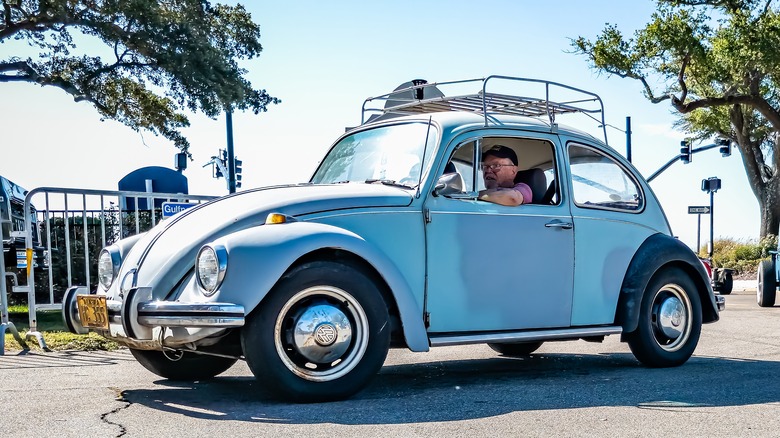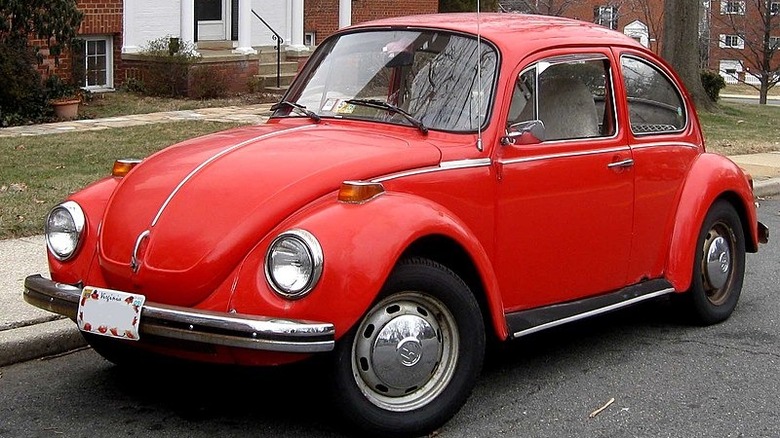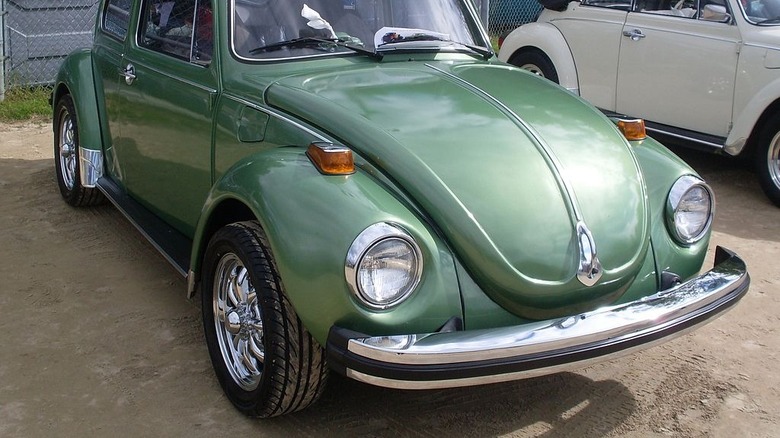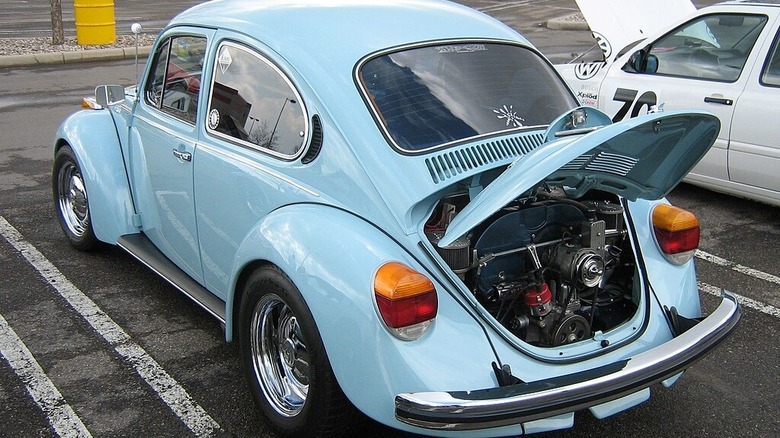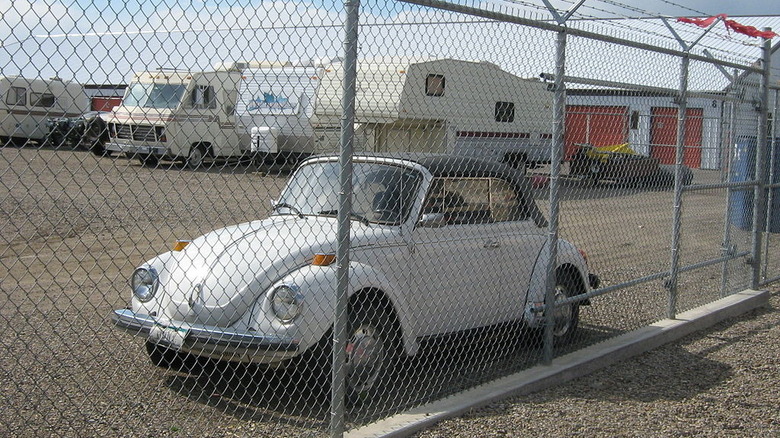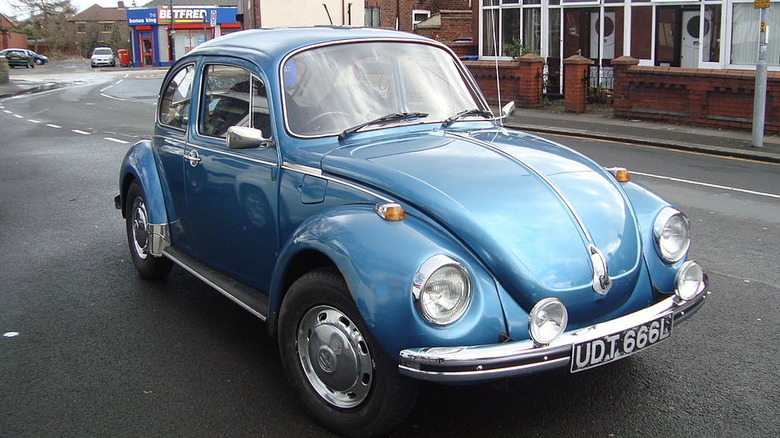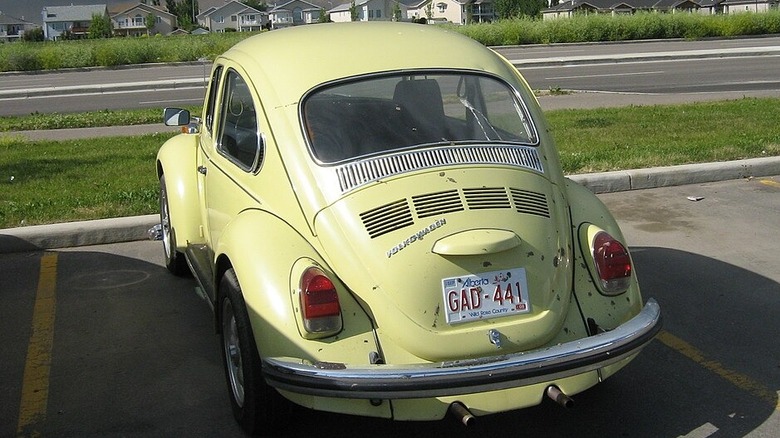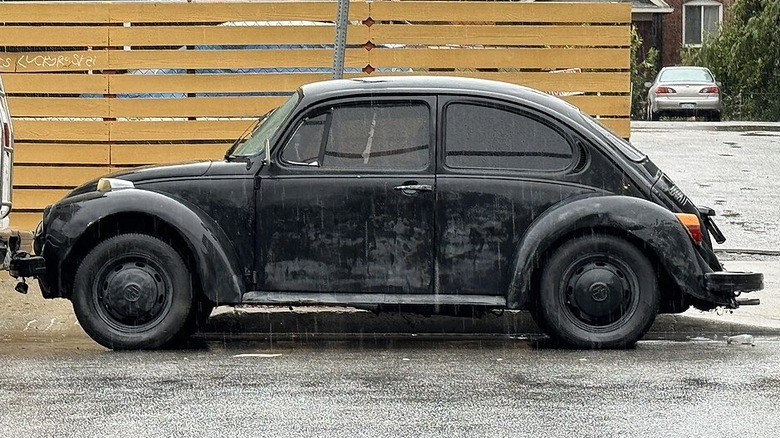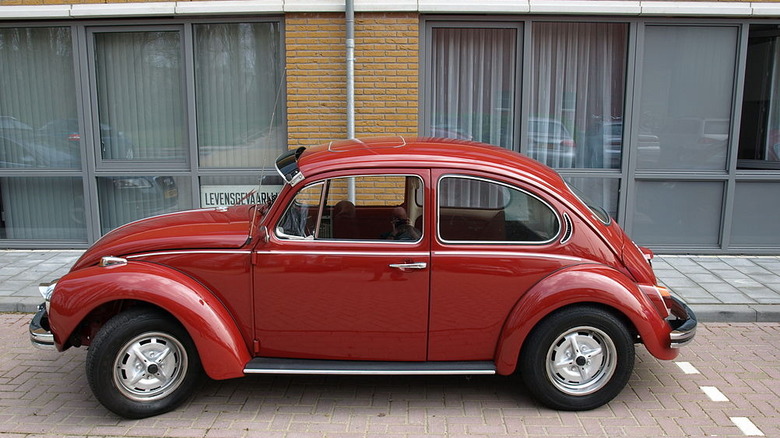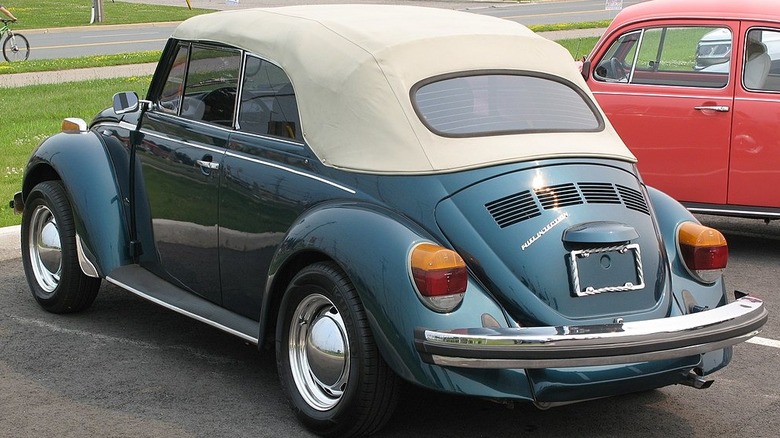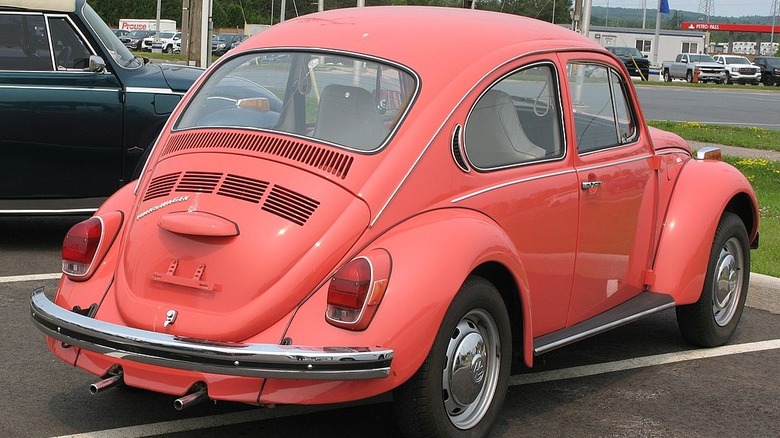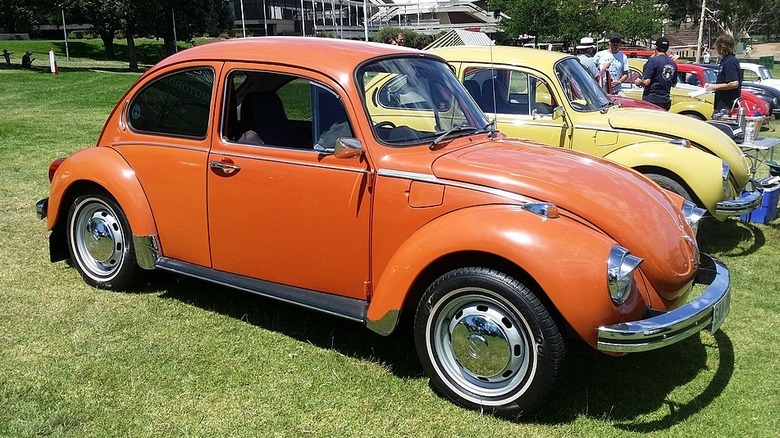10 Ways A Volkswagen Super Beetle Is Different From A Standard Beetle
They've been classics for decades now, but people are still just as interested in Volkswagen Beetles as they were when the car first came out in 1938. While we don't call them Type 1s today — the favorited term is either Beetle or Bug — the earliest Volkswagen turned heads from the moment it rolled off the assembly line in Germany.
Classic Volkswagens are still worth buying today, but as you might expect, not every old VW is the same. Volkswagen released many variations of the Type 1 over the years, and — after a hiatus — modern "new" Beetles were still produced right up until 2019. As for the older VW Bugs, many are still on the road, which can make it hard to tell what model you're looking at.
Almost every iteration of the Beetle made changes, and some years and models have only telltale signs of their differences. Those differences can cause problems when you take your car into the shop or try to order parts.
One of the most distinct types of Beetles is the Super. Super Beetles (1302 and 1303 model numbers) might look the same as a standard Beetle at first glance, but there's much more happening than you might realize. Here are 10 ways that Volkswagen Super Beetles differ from standard Beetles, and how to identify whether yours is Super or Standard.
Vastly different suspension
One of the biggest differences between a Standard and Super Beetle is the suspension on the latter. Super Beetles have a MacPherson front suspension, rather than the standard torsion beam. Once you know what to look for, it's easy to spot; kneeling next to a Super Beetle, you can see the springs.
If you don't know what to look for, that MacPherson suspension can cause problems. I once took my 1972 Super Beetle into a Les Schwab tire center to have the alignment checked. My mechanic had just replaced some parts, and rather than take his chances with manual confirmation, wanted me to go somewhere that had more advanced technology than his shop.
As soon as I rolled into the shop, the tire experts began scratching their heads, and after consulting their system, began telling me that my alignment was way off and that there was something seriously wrong with my car. They went so far as to tell me that they would need to saw off parts of my car to "fix" the suspension.
By this point, I made sure to tell them that my car was a Super Beetle, and that it always looked a bit like it was sitting back on its haunches, with the front end higher up. Once they looked up the specs for a Super Beetle, it turned out my car was well within those parameters, and they were pretty embarrassed. Luckily, I stopped them before they cut anything.
Smoother ride
While most Beetles have decent handling, the original goal was to create an everyday driver without a lot of bells and whistles. The whole point of the sometimes problematic (for many reasons) MacPherson suspension was to create a smoother ride. With the Super Beetle, drivers say the ride is smoother, going so far as to claim the ride is as smooth as a newer car.
Personally, I have test driven a couple of different Beetles and felt like my 1972 Super beat them all, but that might be a personal bias. I've also driven at excessively high freeway speeds (I won't admit to going over 80 mph, but that's high enough) and didn't feel like it was uncomfortably fast.
For most drivers, the suspension difference might not be too noticeable, but if you watch a Super Beetle driving side by side with a Standard Beetle, the visual difference is quite clear. Still, there could be Standard Beetles that drive just as smoothly because of good maintenance or quality replacement parts (or both).
That said, the suspension itself seems to require more work than previous models with torsion beams did — problems are common enough that there are plenty of online forums where drivers discuss still them.
Potential for the Super shimmy
The final problem related to the Super Beetle's MacPherson suspension is the fact that, as happens with many vehicles, parts can eventually fail. Some drivers suggest that the MacPherson parts are more susceptible to wear, while it's also said that the original Standard Beetle's cheaper parts caused the suspension to be a bit rougher.
Whether that's true is hard to say, given how long ago these classic VWs were manufactured, but many Super Beetle drivers have experienced a noticeable failure in the MacPherson suspension. My car developed the same problem, so I have firsthand experience with the "shake" that happens due to the aging of the parts.
A Standard Beetle could also develop a shimmy due to suspension problems, but this particular problem only happens with MacPherson struts. Replacement parts and some time in the shop cured my Beetle, but it's something to be aware of if you have or plan to buy a Super Beetle of any year.
Regular tune ups are part of VW life, but you'll want to check for suspension problems regularly and keep an eye out for any rust. While I never had a rust problem with my Super Beetle, an apparently common problem is the development of rust where the strut towers are welded to the wheel well. The remedy for this issue is to clean and rust-protect the affected area, fill any holes, and repair the strut brace itself before re-attaching it.
[Featured image by dave_7 via Wikimedia Commons | Cropped and scaled | CC BY 2.0]
Bigger measurements
One unique specification on a classic Super Beetle is the fact that they have slightly larger measurements than a Standard Beetle. In fact, one of the simplest ways to tell if you have a Super Beetle is looking under the hood — and not the rear engine compartment hood.
The trunk area in a Super Beetle is wider than a Standard Beetle, manifesting in a larger gap around the spare tire. It also means an extra 3 cubic feet of luggage space. Basically, if you can fit groceries and whatever else in there with your spare tire, you probably have a Super Beetle.
I never realized this size difference because I always drove a Super Beetle and always put my groceries in the front trunk area. Removing the spare tire when I needed to was easy enough, although I never gave much thought to the fact that it fit in there so seamlessly (and hidden under a mat).
It's not explicitly clear just how different a Standard and Super Beetle's measurements are, but many sources claim that the Super Beetle is 2 inches wider. Similarly, Supers are also said to be 2 inches longer in the wheelbase. As is the case with the suspension performance, it's hard to see this difference visually, and it's also difficult to measure the entire length or width of your car accurately.
[Featured image by dave_7 via Wikimedia Commons | Cropped and scaled | CC BY 2.0]
A wider front
One way that the slight size difference between Volkswagen types is easily distinguishable is when you're trying to find replacement parts. I learned a lot about the sizing of Super Beetles when I attempted to replace the hood of my 1972 Super Beetle which, it turns out, is not the same as every other Super Beetle.
For example, a 1973 Super Beetle hood wouldn't fit my car, even though many other things are similar between the two model years. Because there was somewhat of a limited run on 1972 (and any year) Super Beetles, it is, of course, harder to come by original parts. For years, I drove my '72 Super with a smashed-in hood because, despite having hit a deer, the car drove away from the accident with only cosmetic damage. Eventually, after scouring my local Pick-n-Pull for parts and begging my mechanic, I hammered out the biggest dents and kept on driving.
You might not notice the wider front of a Super Beetle unless you had a few model years in a row to compare. Another way to tell is if you need a hood replacement, only to buy one that is almost imperceptibly incorrectly sized... until you try to bolt it on.
[Featured image by Kieran White via Wikimedia Commons | Cropped and scaled | CC BY 2.0]
(Possibly) a curved windshield
Not every Super Beetle was manufactured with a curved windshield, but when comparing two Beetles side by side, this will be another very obvious difference. A curved windshield also means a different style dashboard, and only 1973 Supers had this style change. The idea was that Volkswagen wanted to further distinguish its Super Beetles from previous models, even though the average layperson probably couldn't tell the difference at the time (nor can we today).
In 1973, one of the last years of the non-convertible Super Beetle (standard-body Super Beetles ended in 1975), the curved windshield and switched-up dash created a third difference in the car's overall styling. The roofline also changed almost imperceptibly — again, unless you have precise measurement tools or two vehicles parked next to each other — making for another possible issue when matching replacement parts.
In the grand scheme, unless you need a spare part, the curved windshield doesn't make much of a difference in either the aesthetic or the performance of the Super Beetle. As far as every other aspect of the 1973 Super Beetle, the struts stayed the same, as did most of the other styling decisions.
[Featured image by dave_7 via Wikimedia Commons | Cropped and scaled | CC BY 2.0]
Manufactured for fewer years
The first Type I Volkswagen Beetle came to the U.S. in 1949, and the design began to change almost immediately thereafter. Many Volkswagen enthusiasts can spot specific years based on slight adjustments, or features like vents behind the rear windows or differently colored exterior lights. Having one or two side mirrors is also a distinction that gives hints as to what year Volkswagen Type 1 you're looking at.
By the time the 1970s-era Volkswagens came around, the Super changes were in play. Super Beetles were released from 1970 to 1979, which is a small window compared to the entire lifespan of the Volkswagen Beetle. There were some limitations in the production of the standard-body cars, though. The only years that the standard, non-convertible Super Beetles were manufactured were 1970 through 1975.
Convertible Super Beetles, on the other hand, were released from 1970 all the way through 1979. Thus, if you're looking at an original non-convertible Super Beetle, it has to be a year between 1970 and 1975. Beyond that, there are some specific ways to tell what year Super Beetle it is, but more on that later.
[Featured image by Sarah Stierch via Wikimedia Commons | Cropped and scaled |CC BY 4.0]
Some parts are hard to find
There's a lot of things to consider when buying a classic VW Beetle, and one is how hard it is to find parts. Most standard Beetles are easy enough to shop for, but Super Beetles, in my experience, are a bit trickier.
Generally, Beetle parts are easy to find, which is part of why a classic VW Beetle is a great first car. A Super Beetle has the same highly praised air-cooled engine as always, so the innards aren't really a problem. I never had trouble finding things like replacement throttle cables or fun upgrades (like a center console). But if you need other Super-specific parts — and remember, the model year makes a difference — the selection can get a lot smaller.
If your car needs suspension repairs, a new hood, or a new dashboard, you might run into challenges finding replacements. Many Volkswagen parts vendors offer plenty of inventory, but, for example, to replace my '72 hood, I still would have needed to buy a custom-made fiberglass one or scavenge one from another car.
[Featured image by Theo via Wikimedia Commons | Cropped and scaled | GNU Free Documentation License]
Some convertibles are only Super
If you're looking at a convertible, it could be just about any year VW Beetle. However, some years of VW convertibles are only Super Beetles. It's not clear why some convertibles were made Super Beetles, apart from perhaps the fact that the team behind VW at that time liked to change things up. It also could have been more convenient to make every car within a certain period have the same chassis, whether or not it had a top.
A convertible VW prototype was developed as early as 1935. Then, Volkswagen made assembly-line Beetle convertibles — technically Volkswagen Beetle Cabriolets — from the model year 1949 until 1980.
Interestingly, Volkswagen did produce non-Super Cabriolets, but for a time, did not manufacture any convertibles that were not Super. Multiple sources claim that no standard convertibles were manufactured between 1972 and 1979. If you can pinpoint a convertible between those years, it can only be a Super Beetle.
Convertibles also had some differences between model years though, including engine sizes ranging from 1100cc to 1600cc. In 1972, Cabriolets got a steel frame, instead of part steel and part wood. Apparently, the only consistent feature of the convertible was the running boards.
[Featured image by Elise240SX via Wikimedia Commons | Cropped and scaled | CC BY 4.0]
The Super is less popular
Anecdotally speaking, many classic VW Bug drivers seem to dislike Super Beetles. There seems to be a perception that they are not "true" Beetles because of all the differences versus the standard classic Beetle. Not to mention the fact that the MacPherson suspension has created quality issues that don't seem to exist with a Standard Beetle.
It seems some VW enthusiasts also feel that the original lines of the VW Beetle are the only right ones, and therefore Super Beetles just don't "look right." For that reason, many enthusiasts also prefer earlier-model Beetles as they are perceived as truly "classic."
I disagree with that position because Volkswagen changed so many things so many times, but it might mean there are more Super Beetles to go around for those who do want them.
Some drivers might also dislike Super Beetles because of the replacement part issue, and I can understand that. Still, having driven mine for a long time, I haven't yet given up on it, even though it was in an engine-destroying rear-end collision years ago.
[Featured image by Elise240SX via Wikimedia Commons | Cropped and scaled | CC BY 4.0]
How to tell if you have a Super Beetle
There are a few ways to tell if you have a Super Beetle, and many of them are straightforward. If there's room around the spare tire for assorted sundries, you have a Super Beetle. Parked next to a car that you know to be a Standard Beetle, you can also compare sizing to determine if yours is Super.
Another way to tell is by looking at your dashboard and windshield. If your windshield is curved and the dashboard is padded, not only do you have a Super Beetle, but that would be a 1983 Super or later. One somewhat labor-intensive way to confirm a Standard or Super is by measuring the length and width of a car. Wolfsburg West's advice is to check your Super Beetle for the telltale springs under the front fender, and that's simple enough.
All that aside, you can also just check the chassis number, aka the VIN. It's printed under the back seat cushion of your, on an inspection plate. Specific chassis numbers apply to Super Beetles, though they differ with each year.
Wolfsburg West provides a range of numbers that you can consult to see where your Beetle lies. For example, my 1972 Super Beetle should have a chassis number between 1122000001 and 1123200000. This is a foolproof way to check your Beetle's type, especially if aftermarket modifications took away any of the other Super signs.
[Featured image by TuRbO_J via Wikimedia Commons | Cropped and scaled | CC BY 2.0]
